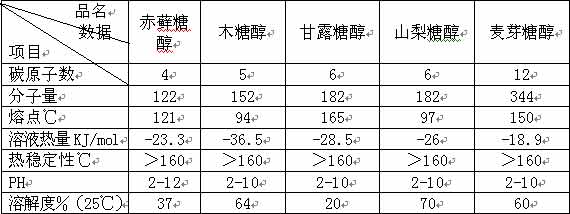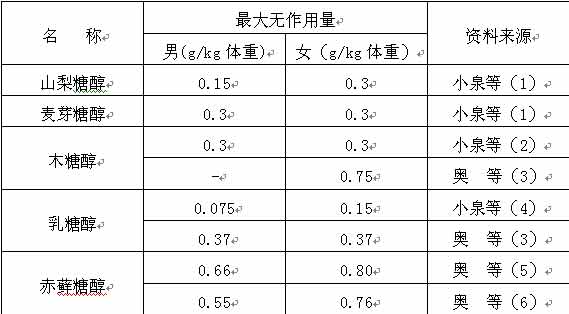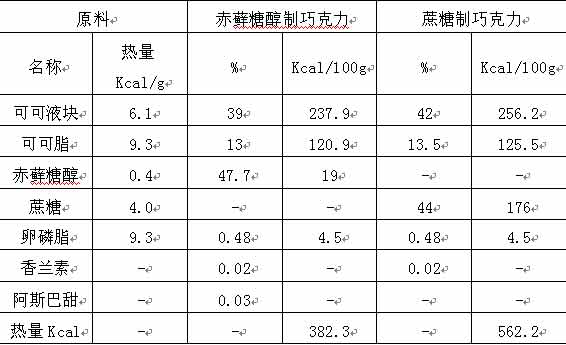
Privacy statement: Your privacy is very important to Us. Our company promises not to disclose your personal information to any external company with out your explicit permission.
![]() July 08, 2021
July 08, 2021
Abstract: Erythritol is a new type of natural sweetener that can be widely used in a variety of foods, and can bring a good taste and give a wonderful taste. This paper mainly introduces the application of erythritol in sugar-free candy.
Key words: erythritol; sugar-free candy; application
Foreword
Excessive intake of carbohydrates and calories from the diet often causes certain illnesses. For example, dental caries, diabetes, rheumatic diseases and cardiovascular diseases. With the popularization of science, people pay more and more attention to the nutritional balance of food health care. The importance of diet for human health has been a concern. There are low-fat, low-sugar or fat-free, sugar-free and low-calorie functional foods on the market. No exception, sugar-free candy has been developed in recent years. It uses low-calorie sweeteners instead of sucrose, glucose, etc. used in traditional confectionery manufacturing to reduce the calorie of the product, which is very popular among consumers. It is more common to use sugar alcohols and the like in low-calorie sweeteners.
According to the data, the current output of sugar-free candy in the European, American and Japanese markets is increasing year by year. Among them, the development of gum and hard candy is faster. For example, in Japan, sugar-free candy (less than 0.5g of sugars such as monosaccharides and disaccharides in 100g, sugar alcohols are not included in the sugar) is about 2% of traditional gum sugar in 1993, 1995. Increased to 12%, 20% in 1997 and 36% in 1999, showing rapid development. Sugar-free fruit hard candy accounts for 2-3% of traditional confectionery in 1995, 5-6% in 1997, and more than 10% in 1999, and has increased year by year.
Introduction to erythritol
Erythritol is a type of filled sweetener popular in the 21st century and is known as the "zero" calorie ingredient. Erythritol has the characteristics of good crystallinity, low hygroscopicity and easy pulverization. It is not hygroscopic in the environment with relative humidity above 90%, and it is more difficult to absorb moisture than sucrose. Erythritol is very stable to heat and acid. Under normal food processing conditions, there is almost no browning or decomposition, and it can resist hard candy production. The high temperature is boiled without browning.
The nature of erythritol
At present, although there are many non-sugar sweeteners for making sugar-free candy, they have some shortcomings: 1 the heat is not obvious 2 may cause digestive system discomfort 3 flavor is not ideal 4 storage stability is poor 5 affect product organization The incremental nature is not obvious.
Erythritol is a natural four-carbon sugar alcohol found in many microorganisms, plants and animals, and many foods also contain naturally occurring erythritol.
It is a linear carbohydrate with four carbon atoms. Each carbon contains a hydrocarbon group. Like sorbitol, mannitol and xylitol, it belongs to the monosaccharide polyol. It is a symmetrical molecule, so it is only A meso-type appears.
Erythritol is white, bright powder or crystalline, soluble in water and a colorless, non-viscous liquid. Its chemical properties are similar to other polyols, as follows:
(1) Heat resistance
Erythritol has a high heat resistance, and does not cause decomposition and heating discoloration even under high temperature conditions; it does not contain a reducing end group, and even if the amino acid coexists, the Maillard reaction does not occur.
(2) Hygroscopicity
The hygroscopicity of erythritol is the smallest among sweeteners such as sugar alcohols and sucrose. In an environment with a temperature of 20 ° C and a relative humidity of 90%, the moisture absorption after five days of storage, sorbitol is about 40%, maltitol is about 17%, sucrose is about 10%, and erythritol is 2 %the following.
(3) Dissolved heat
When erythritol is consumed in a crystalline state, it will have a cooling sensation in the oral cavity. The heat of dissolution in water is about three times that of glucose and two times that of sorbitol.
(4) Osmotic pressure and water activity
Compared with other sugar alcohols, erythritol has a relatively low molecular weight of only about 1/3 of sucrose. Therefore, its solution has a high osmotic pressure and low water activity, and the unit weight has a great effect on the reduction of water activity. The osmotic pressure of the aqueous solution of erythritol at 20 ° C and 15% (W/W) was 1861 mosm/kg, which was 3.2 times that of granulated sugar and 1.8 times that of sorbitol. The water activity of the aqueous solution of erythritol at 25 ° C and 36% (W/W) is 0.91, which is not easily used by microorganisms in foods, and can effectively improve the shelf life of foods.
(5) Sticky
The viscosity of erythritol is low, and the viscosity of the aqueous solution of erythritol at 25 ° C and 30% (W/W) is only 3.0 cp, which is easy to use in food processing.
Comparison of physical and chemical properties of erythritol and other sugar alcohols

(1) Sweetness characteristics
The sweetness of erythritol is 60%-70% of sucrose. When dissolved in water, it absorbs more energy, dissolves heat -97.4J/g, and has a cool taste characteristic when used. Its sweet taste is pure, its sweetness is good, and it is very close to the sweetness of sucrose. The sweetness properties when used in combination with saccharin, aspartame, and acesulfame are also good, masking the unpleasant taste or flavor normally found in intense sweeteners. For example, erythritol and stevioside can be used in combination with 1000: (1-7) to mask the bitter taste of stevioside.
(2) Nutritional and functional properties of erythritol
Although it is chemically a polyol, it has a unique molecular weight in the formulation of healthy foods due to its small molecular weight, which is different from that of other polyols.
Erythritol has the following nutritional properties: 1 contains very low calories, almost close to zero, excellent digestive tolerance, 3 pairs of diabetes, 4 non-cavity
It is rapidly absorbed in the small intestine, 80% is quickly excreted from the urine, and there is very little residual decomposition. It does not affect the blood sugar level and is therefore acceptable to diabetic patients. Since it cannot be used by microorganisms in the mouth, it does not cause dental caries.
Maximum no effect of erythritol and certain sugar alcohols

(1) Chemosphere12(1)45-53(1983)(2) Unpublished data (3) The2ndAsianCongressDietetics lecture series 220-227 (1998) (4) Japanese Society of Food Chemistry 4 (1) 27-32 (1997) (5) Nutrition Research 16 (4) 557-589 (1996) (6) Riken Chemical Co., Ltd.
(3) Metabolic characteristics
Erythritol is a small molecule that is easily absorbed by the small intestine by passive diffusion. Most of it can enter the blood circulation, and only a small amount directly enters the large intestine as a carbon source for fermentation. However, erythritol entering the blood can not be digested by the enzyme system in the body, but can only be filtered out of the blood through the kidneys and excreted through the urine.
Because of its unique metabolic properties, it determines its extremely low energy value. 80% of the erythritol entering the body is excreted in the urine, which obviously does not provide energy. Another 20% entered the large intestine, assuming that half of them (already the largest estimate) were fermented by the intestinal bacteria into unsaturated fatty acids and reabsorbed and metabolized. This analysis shows that up to 5-10% of the ingested erythritol has an energy value, providing a source of energy for the body. The energy value of erythritol is only 0.84 KJ/g, which is the lowest energy value of all polysaccharide sweeteners.
### (4) High tolerance
Since 80% of the erythritol entering the body is quickly and completely absorbed by the small intestine, the side effects of non-absorbent substances are avoided.
The non-absorbed carbohydrates at the inner wall of the small intestine produce a high osmotic pressure, which causes water to flow on the mucosal surface of the small intestine wall, causing diarrhea. The undigested carbohydrates enter the large intestine and are fermented by the intestinal bacteria to produce a large amount of volatile substances, which exceeds the limit of the amount that can be reabsorbed by the blood and discharged with the feces, thus producing flatulence. The extent of these two side effects is also related to the specific physical fitness of the ingestor. In severe cases, abdominal cramps and intestinal tumbling sometimes occur. For the erythritol phenomenon, since most of it can be absorbed by the small intestine, it is highly tolerated and has few side effects.
Ordinary people taking 30-50g / d will not cause side effects on the body.
Erythritol has good heat and acid stability, and it has a significant endothermic cooling effect when dissolved in water. This property makes it suitable for gum and sugar. Its excellent thermal stability makes it not decompose or discolor at 170 ° C, it is not easy to decompose in acid-alkaline environment, and it can remain stable after ph2-12 for a certain period of time.
It has a solubility of 37% at 25 ° C and has good crystalline properties. If high viscosity maltose is added, it can inhibit its crystallization.
(5) Using erythritol to make sugar-free candy
Due to the special nutrition, functional properties, physical and chemical properties of erythritol, it has been used in the manufacture of sugar-free candy abroad. The use of erythritol in confectionery can reduce the calorie of the product; for example, it replaces traditional sweeteners in gum, but the calorie is reduced by about 85%, and the calories are reduced by about 30% in chocolate...
In addition to reducing the amount of heat in the candy formula, erythritol can improve the digestion tolerance of low-calorie candy and improve the flavor, texture and storage stability of the product.
Strong sweeteners such as aspartame and acesulfame, because of their high sweetness, are rarely used in food manufacturing and cannot be incremental. The combination of erythritol and them can change this situation. Gives a very similar flavor to sugar.
1, chocolate
When replacing granulated sugar in the formula with erythritol, it is only necessary to make minimal adjustments in conventional manufacturing. It has good thermal stability and low hygroscopicity, allowing it to be refined at higher temperatures (80 ° C), reducing operating time and improving product flavor.
Recipe example

If the chocolate calorie (562.2Kcal/100g) made with sucrose as a sweetener is 100, the calorie chocolate calorie (382.3Kcal/100g) is only 68, which can reduce heat by about 32%.
Operation points
Mix erythritol, cocoa liquor (liquid) and 5-10% cocoa butter in a mixing machine at 30-40 ° C for 10-15 min, then finely grind in a five-roll refiner, scouring for 16-22 h, temperature Not more than 80 ° C, the remaining cocoa butter and lecithin are added near the end of refining. For example, when the refining time is 16h, the remaining cocoa butter can be added after 14h, and after 15h, lecithin is added to adjust the temperature (28-31 ° C). If you feel that the sweetness is not enough, you can add a small amount of aspartame to correct (0.03%).
2, gum candy
Since the erythritol solution is apparently thermally reacted, the gum candy has a pleasant and refreshing taste.
Formulation example (raw material and dosage %)
Gum base 30 erythritol 55
Maltitol syrup 13 glycerin 2
Operation points
The gum base was heated to 60 ° C for mixing. Continue mixing and add maltitol syrup, add 1/3 erythritol for 6min, add 1/2 glycerol for 1min, add 1/3 erythritol for 6min, add another 1/2 glycerol for 1min, add the remaining The 1/3 erythritol was mixed for 6 min, discharged and cooled.
The gums with good appearance, texture, chewiness and stability can be obtained by the above process, wherein the operating temperature is a key factor. When used in combination with sorbitol, it improves flexibility and extends shelf life.
The following formula is said to produce a harder gum (% of raw materials and amount)
Gum base 38.0 erythritol 45.5
Maltitol (75%) 2.0 mannitol 10.0
Glycerin 3.0 Mint Flavor 1.5
It is best to use erythritol with a particle size of less than 300 μm in the formulation to avoid sand structure.
3, Fang Deng sugar
When erythritol is mixed with maltitol, it can be made into a sugar-free fang, which has a good texture, tastes alcohol and cool, and has a good texture. Different kinds of tissues can be obtained according to the mixing time and temperature in the operation. Made from erythritol ingredients, Fangdeng has good shelf stability due to its low residual moisture content and water activity. The product can reduce heat by about 65%.
Formulation example (raw material and dosage %)
Erythritol 50
Maltitol syrup (75% maltitol) 50
Operation points
The erythritol is dissolved in the maltitol syrup, boiled to about 140 ° C, then cooled to 40-50 ° C, and the pieces are whipped for 5-10 min to obtain the desired tissue and crystals. The square is placed in the container for one day to ripen.
4, soft toffee (Fudge)
Formulation example (raw material and dosage %)
Erythritol 22.5 maltitol syrup (75%) 45.5
Water 5.5 cocoa butter 7.5
Unsweetened condensed milk 18.7 sodium bicarbonate 0.2
Operation points
1 Heat erythritol, maltitol and water to ±70 °C.
2 Add unsweetened condensed milk, melted cocoa butter, etc., homogenize for 2 min
3 Continue cooking the mixture to ±140 °C.
4 Cool to ±100 ° C, access to seed crystals (erythritol solution)
5 cooling, cutting and forming
When erythritol is mixed with a strong sweetener, it can be made into a "sugar candy" with a taste and texture similar to sucrose or a tabletop sweetener that can be spooned, reducing the heat by about 90%. In baked products, erythritol can be used in cookies and pastries, in addition to reducing heat, it can improve baking stability and extend shelf life. Because of its good water retention, the dough can be made firmer and the product is softer and lighter in color.
Erythritol has been used in the Japanese market, and the US FDA has passed GRAS through extensive safety tests.
The above is the Characteristics of erythritol and its application in sugar-free candy we have listed for you. You can submit the following form to obtain more industry information we provide for you.
You can visit our website or contact us, and we will provide the latest consultation and solutions
Send Inquiry
Most Popular
lastest New
Send Inquiry

Privacy statement: Your privacy is very important to Us. Our company promises not to disclose your personal information to any external company with out your explicit permission.

Fill in more information so that we can get in touch with you faster
Privacy statement: Your privacy is very important to Us. Our company promises not to disclose your personal information to any external company with out your explicit permission.